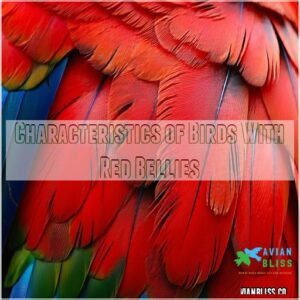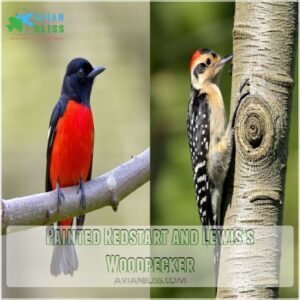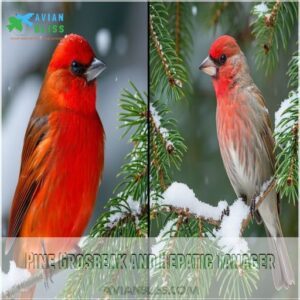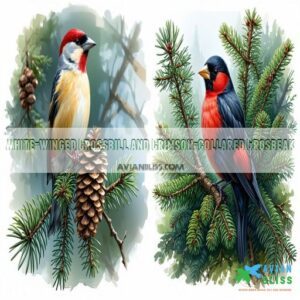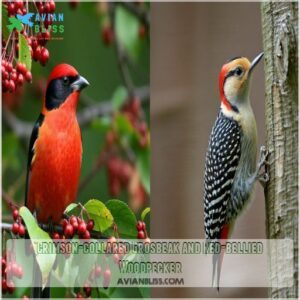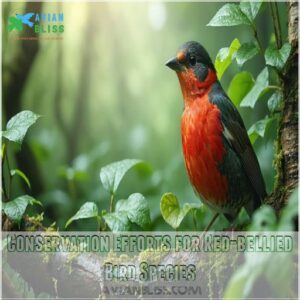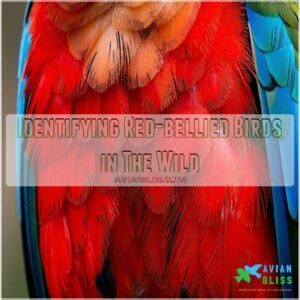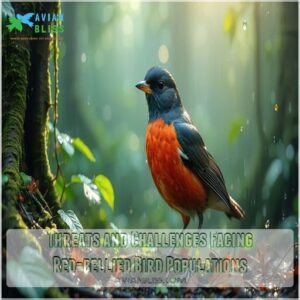This site is supported by our readers. We may earn a commission, at no cost to you, if you purchase through links.

These avian wonders, like the Hepatic Tanager or the Scarlet Tanager, flaunt their red bellies across diverse habitats—from lush rainforests to bustling urban parks.
This brilliant hue often plays a starring role in courtship dances and acts as a flashy billboard telling predators to back off.
Whether they’re munching on berries or impressing potential partners, these birds are a sight to behold!
Curious about their diet or habitats?
There’s much more to explore in their fascinating world.
Table Of Contents
- Key Takeaways
- Characteristics of Birds With Red Bellies
- North American Birds With Red Bellies
- Central and South American Birds With Red Bellies
- Birds With Red Bellies: Beyond The Americas
- Detailed Profiles of Birds With Red Bellies
- Ecological Roles and Habitats of Red-bellied Birds
- Conservation Efforts for Red-bellied Bird Species
- Identifying Red-bellied Birds in The Wild
- Red-bellied Birds and Their Cultural Significance
- Threats and Challenges Facing Red-bellied Bird Populations
- Frequently Asked Questions (FAQs)
- What kind of bird has a red stomach?
- What bird looks like a sparrow but has a red chest?
- What is the name of the red-breasted bird?
- What bird has a red breast besides a robin?
- What bird has red bellies?
- Is there a red on a bird’s belly?
- Where do birds with red bellies live?
- What bird has a red chest?
- Which bird has a red belly?
- What kind of bird has a reddish chest?
- Conclusion
Key Takeaways
- You’ll find birds with red bellies in diverse habitats worldwide, from rainforests to urban parks, showcasing their vibrant hues for courtship and predator deterrence.
- These birds play essential ecological roles, such as pollinating plants and controlling insect populations, adapting their foraging habits to seasonal availability.
- Climate change and habitat destruction are significant threats, reshuffling their distribution and risking population declines, highlighting the need for conservation efforts.
- Enjoy identifying these birds by their distinctive markings, feeding habits, and vocalizations, enhancing your appreciation for their striking presence in nature.
Characteristics of Birds With Red Bellies
You’ll find red-bellied birds in diverse habitats worldwide, from woodlands to grasslands, where males often display this vibrant coloring as a breeding advantage.
Many species, including the Painted Redstart and Golden Pheasant, show variations in their red belly patterns, which can range from subtle pink hues to brilliant crimson markings.
Evolutionary Significance of Red Bellies
While you might think a bird’s red belly is just for show, it’s actually a fascinating product of evolution.
These vibrant displays serve three critical purposes:
- Sexual selection: Brighter bellies often signal better genes to potential mates
- Social signaling: Red plumage helps establish dominance in food competition
- Predator deterrence: The bold coloring can startle or warn predators, similar to how poisonous animals use bright colors
It’s nature’s way of turning survival into an art form.
Habitat and Geographic Distribution
You’ll find red-bellied birds across diverse habitats worldwide, from dense rainforests to arid deserts.
Their distribution patterns often reflect evolutionary adaptations to specific environments.
| Region | Common Habitats | Notable Species |
|---|---|---|
| Americas | Pine forests, grasslands | Hepatic Tanager, Elegant Trogon |
| Asia | Mountain woodlands, wetlands | Golden Pheasant, Rosefinch |
| Africa | Savannas, coastal areas | Common Waxbill, Sunbirds |
Climate change and habitat loss continue to reshape these birds’ traditional ranges, making conservation efforts essential for their survival.
Dietary Preferences and Foraging Habits
Most red-bellied birds display diverse feeding habits that adapt to their environments.
You’ll find them gathering seeds from pine cones, snatching insects mid-flight, or carefully extracting nectar from flowers.
Some species, like the Elegant Trogon, hunt small lizards and insects, while others, such as the Crimson-collared Grosbeak, prefer fruits and berries.
Their foraging techniques often reflect the seasonal availability of food sources.
Breeding Success and Mating Behaviors
The stunning red bellies of many bird species play a starring role in their love lives.
During courtship, males flaunt their vibrant colors through intricate displays and dances, with brighter reds often leading to greater breeding success.
You’ll find these birds building elaborate nests, sharing parental duties, and forming strong pair bonds that can last multiple seasons – nature’s own version of "till death do us part.
North American Birds With Red Bellies
You’ll find a spectacular variety of red-bellied birds across North America, from the striking Painted Redstart in the southern states to the Pine Grosbeak in northern forests.
Whether you’re watching a Lewis’s Woodpecker flash its crimson underside or spotting a Hepatic Tanager’s vibrant belly in the sunlight, these distinctive birds add splashes of color to our continent’s diverse landscapes.
Painted Redstart and Lewis’s Woodpecker
In North America’s vibrant bird population, two standout species catch the eye with their distinctive red bellies.
Painted Redstarts flash their crimson bellies while hopping through southwestern woodlands, often performing aerial displays to catch insects, and are particularly recognizable by their distinctive wing flashing behavior.
Lewis’s Woodpeckers, named after explorer Meriwether Lewis, showcase their rosy-red underparts as they gracefully swoop between trees, primarily feeding on flying insects and acorns during warm months.
Pine Grosbeak and Hepatic Tanager
Moving swiftly through North America’s forests, you’ll spot Pine Grosbeaks and Hepatic Tanagers bringing splashes of red to the tree canopy.
Male Pine Grosbeaks showcase vibrant red plumage while females opt for subtle gray tones.
Their diets mainly consist of pine seeds and berries.
Meanwhile, Hepatic Tanagers display striking red bellies in males, though females rock a more muted yellow-orange look, making bird identification a fun challenge in the field.
White-winged Crossbill and Crimson-collared Grosbeak
Both the White-winged Crossbill and Crimson-collared Grosbeak showcase nature’s eye-catching red plumage, but they’re quite different in their habits.
You’ll spot Crossbills in coniferous forests, where they can be attracted with specialized Crossbill seed feeders, while Grosbeaks prefer dense shrubbery.
Here’s what makes these red-bellied birds unique:
- Crossbills have specialized curved beaks for extracting seeds from pine cones
- Grosbeaks sport distinctive black wings with red bars
- Crossbills travel in noisy flocks year-round
- Grosbeaks are primarily solitary, except during breeding season
Central and South American Birds With Red Bellies
You’ll discover vibrant species like the Elegant Trogon and Red-breasted Toucan showcasing their stunning red bellies throughout the diverse landscapes of Central and South America.
From Mexico’s pine forests to Brazil’s rainforests, you’ll find these remarkable birds displaying various shades of red on their undersides.
Often paired with metallic green, blue, or black plumage on their backs.
Elegant Trogon and Flame-colored Tanager
The colorful Elegant Trogon stands out among Central American birds, with its metallic green body and striking red belly divided by a white band.
You’ll often spot these eye-catching birds in Southeast Arizona’s oak forests.
Meanwhile, the Flame-colored Tanager lights up the canopy with the male’s brilliant red plumage, while females sport a distinctive yellow-green color that helps them blend into their forest home.
Eared Quetzal and Crimson-backed Tanager
Commonly spotted in Mexico’s rugged canyons, you’ll find the majestic Eared Quetzal flashing its iridescent green body and striking red belly. Meanwhile, the Crimson-backed Tanager adds a splash of color to Northwestern South America’s landscapes.
Key features you’ll love about these red-bellied beauties:
- Eared Quetzals reach 14 inches with a 24-inch wingspan
- Both sexes of Crimson-backed Tanagers display dark red bellies
- Quetzals favor Madrone tree fruits
- Tanagers thrive in lowland forests and gardens
Red-breasted Toucan and Surucua Trogon
Round the corner from Eared Quetzals, you’ll find the Red-breasted Toucan and Surucua Trogon lighting up South American forests.
These red-bellied species sport stunning plumage—a toucan’s beak only matches its bright belly, and the trogon’s vibrant colors steal the show.
Bird lovers marvel at these habitats, so join in, get out there, and deepen your bird identification skills.
Birds With Red Bellies: Beyond The Americas
If you think birds with red bellies are only found in the Americas, think again, because they actually inhabit diverse regions across Asia, Africa, and Australia.
These vibrant species, like the Golden Pheasant and the Common Waxbill, bring their dazzling colors and unique behaviors to ecosystems worldwide, charming birdwatchers wherever they go.
Golden Pheasant and Long-tailed Rosefinch
Golden pheasants, with their striking red bellies, boast vibrant plumage that shines in Asian forests.
Long-tailed rosefinches flaunt pink hues across diverse habitats in Asia, unlike their native cousins.
During breeding season, these red-breasted birds showcase dazzling courtship displays.
Their conservation status varies, with habitat preservation efforts critical to sustaining these enchanting red belly bird species.
Common Waxbill and Blue-crowned Trogon
Birdwatching, with colorful birds like the Common Waxbill and Blue-crowned Trogon, reveals nature’s art.
The Common Waxbill, found across its broad African distribution, showcases a vibrant red belly.
In contrast, the Blue-crowned Trogon dazzles with its striking mix of colors and enchanting vocalizations.
Understanding these red-bellied bird species enhances appreciation for their diverse habitats and important ecological roles.
Australian King-Parrot and Scarlet Tanager
The Australian King-Parrot, with its vibrant red belly and green wings, thrives in eastern Australia’s forests, offering a stunning sight for birdwatchers.
The Australian King-Parrot and Scarlet Tanager showcase nature’s vivid palette, reminding us how essential conservation and habitat preservation are for maintaining their colorful beauty.
Meanwhile, the Scarlet Tanager, boasting a fiery red body, graces North American woodlands during breeding season.
Detailed Profiles of Birds With Red Bellies
Here you’ll find detailed descriptions of several birds sporting striking red bellies, including their size, diet, and habitat.
You’ll learn how to distinguish between species like the Cassin’s Finch and the flamboyant Eared Quetzal,
discovering fascinating facts along the way.
Cassin’s Finch and Eared Quetzal
Cassin’s Finch chats through the mountain evergreens, flaunting its brownish-red plumage with pink streaks, a striking mix of black-and-white patterns that’s typical of many red-bellied birds like these examples. This bird loves earthworms but won’t say no to a beetle.
Meanwhile, the Eared Quetzal graces Mexico’s canyons with its shimmering green feathers and red belly.
Savoring fruits and crickets, it’s like nature’s vibrant art on two wings.
Elegant Trogon and Hepatic Tanager
Spot the Elegant Trogon in oak forests of Arizona, boasting a shiny copper-green back and striking rosy-red belly.
Much like spotting a jewel in a tree!
Meanwhile, the Hepatic Tanager, found in pine woodlands, sports a fiery orange-red belly.
These birds’ bold colorations enhance their plumage, helping them in mating rituals and combining conservation efforts with stories of vibrant beauty.
Crimson-collared Grosbeak and Red-bellied Woodpecker
Imagine you’re strolling in Texan woodlands.
Look out for the Crimson-collared Grosbeak, flaunting its striking crimson and black plumage, often attracted to Grosbeak bird feeders.
It snacks on berries and fruits, adding flair to its forest habitat.
Meanwhile, the Red-bellied Woodpecker drums rhythmically, feeding on insects and nuts.
Both birds highlight nature’s palette, offering vibrant glimpses of wildlife across varied habitats, perfect for bird enthusiasts.
Ecological Roles and Habitats of Red-bellied Birds
You’ve probably seen birds with striking red bellies flitting through forests or prancing across open grasslands, effortlessly playing key roles in their ecosystems.
These colorful birds aren’t just pretty to look at; they help pollinate plants, control insect populations, and even adapt to bustling urban environments like seasoned city-dwellers.
Forest Dwellers and Grassland Inhabitants
Ever wondered how red-bellied birds navigate forest and grassland habitats?
These adaptable creatures boast unique forest adaptations and clever bird camouflage techniques for survival.
In forests, they blend seamlessly with the foliage.
In grasslands, their diets are diverse, from seeds to insects.
Often, there’s a habitat overlap where competition dynamics challenge even the savviest forest dwellers and grassland inhabitants.
Aquatic Ecosystems and Desert Landscapes
As you explore diverse habitats, look at how some red-bellied birds thrive in unexpected places like aquatic ecosystems and desert landscapes.
Riparian zones attract species like the Magnificent Frigatebird, while oasis birds and Vermilion Flycatchers highlight desert bird diversity.
Adaptations for drought resilience allow species like the Pyrrhuloxia and Painted Bunting to flourish amidst arid conditions, showcasing nature’s resourcefulness.
Urban Adaptation and Human Interactions
Some red-bellied birds are surprisingly adaptable city dwellers.
You might spot them foraging in urban parks, finding insects and seeds amidst the concrete jungle. They can also thrive in backyards with native plants and bird feeders, which provide essential food and shelter.
However, habitat loss from urban sprawl is a major threat.
Noise pollution can also impact their behavior and communication.
Bird feeders can help, but improper feeding can cause problems.
Understanding human-bird interactions is key to their urban survival.
Conservation Efforts for Red-bellied Bird Species
When you’re interested in helping red-bellied birds, it’s all about focusing on preserving their natural habitats and restoring the areas they call home.
By joining citizen science projects, you can track these birds’ movements and observe how climate change impacts their distribution.
all while having a birdwatcher’s excitement at seeing these vibrant creatures.
Habitat Preservation and Restoration Initiatives
Red-bellied birds play pivotal roles in ecosystems, kinda like unsung heroes in a superhero film.
Engage communities: Get locals involved in habitat restoration. Secure funding: Tackle efforts with sustained financial support. Connect habitats: Guarantee trails and areas are linked for birds to roam free.
By protecting their spaces, you’re also preserving the harmonious symphony of nature, and these birds are truly the unsung heroes.
Climate Change Impacts on Distribution
Climate change is reshuffling bird distribution like a game of musical chairs, dramatically altering red belly bird ranges.
You might find birds migrating to new territories as their old habitats shrink or vanish.
These shifts, driven by habitat loss and range changes, lead to population declines and heightened extinction risks, pushing birds to adapt or face the consequences.
Citizen Science Projects for Monitoring Populations
To explore climate impacts on bird populations, jump into citizen science projects.
These involve birdwatching enthusiasts like you in data collection, tracking red belly bird sightings.
By participating, you aid in understanding population trends, applying data analysis techniques, and assisting in red belly bird conservation.
Share your findings for result dissemination and enjoy the freedom of contributing to scientific research with fellow nature lovers.
Identifying Red-bellied Birds in The Wild
Spotting a red-bellied bird in the wild is like finding a ruby hidden in the leaves; their vibrant underbellies can be a striking clue.
To identify these colorful creatures, look for key physical features such as markings, observe their feeding habits, and listen for unique vocalizations.
Physical Features and Distinctive Markings
Spotting red-bellied birds? Look for vibrant plumage patterns and hues.
These birds flash red bellies, framed by unique shapes and sizes.
They might’ve striking wing markings or bold eye lines, making them stand out.
Whether it’s a small finch or a larger trogon, their colorful features act like a billboard saying, "Here I am! red-bellied birds" vibrant plumage.
Behavioral Traits and Feeding Habits
Observing red-bellied bird behavior provides insights into their survival strategies.
Their foraging strategies vary widely depending on the species and their diet. You’ll find they’ve different approaches to finding food.
- Some are ground foragers, skillfully picking up insects and seeds.
- Others are acrobatic tree climbers, adept at snatching fruits and berries.
- Dietary variations exist; some are insectivores, while others are omnivores.
- Predator avoidance is key; clever camouflage and quick escapes are common.
Vocalizations and Courtship Displays
When you’re out in nature, listening for bird songs can feel like eavesdropping on a vibrant opera.
Mating calls of red-bellied birds are often intricate, resembling vocal duets. These songs play essential roles in courtship rituals and breeding success, often involving bird vocalizations like complex songs.
Nest building becomes synonymous with harmony in nature, vocalizations are as essential as sunshine and freedom, drawing potential mates together. breeding success, and courtship rituals.
Red-bellied Birds and Their Cultural Significance
You’ll discover that red-bellied birds have captured human imagination across cultures, symbolizing traits like passion and transformation in various folklore.
Understanding these cultural connections can deepen your appreciation for these vibrant birds.
possibly giving you an amusing reason to discuss their charm at your next dinner party.
Symbolism and Folklore in Different Cultures
Across cultures, red-bellied birds inspire rich symbolism.
In mythology, they often represent passion and energy. The cardinal, for instance, is associated with divine guidance and solace.
Folklore varies, seeing them as messengers of love or omens of change. Spiritual beliefs link them to energy or fire elements.
Exploring red belly bird symbolism unearths tales where these vibrant creatures weave through life’s tapestry, whispering secrets only nature understands.
Conservation Efforts and Community Engagement
Storytelling adds layers to conservation efforts, inspiring you to join community outreach and educational programs.
Citizen science projects empower everyone to monitor bird habitats and contribute to wildlife conservation.
Through fundraising initiatives, communities support bird conservation and protect against the bird trade and endangered species threats.
Embrace these efforts as your chance to make a real impact on our feathered friends’ futures.
Threats and Challenges Facing Red-bellied Bird Populations
You’re about to discover the pressing threats facing red-bellied bird populations.
From habitat destruction and fragmentation to the impacts of climate change, which can test even the hardiest bird’s resilience.
As humans spread into more natural areas, these vibrant birds might find themselves dodging everything from urban sprawl to gusty storms, making their lives a real feathered obstacle course.
Habitat Destruction and Fragmentation
Habitat destruction isn’t just a buzzword; it’s a real threat to red-bellied birds, slicing up their forest homes like a pizza, only with fewer tasty toppings.
This fragmentation effects lead to species decline, adding pressure on conservation strategies to piece together these havens.
Without quick mitigation solutions, endangered species might face extinction risks, diminishing vibrant bird habitats forever.
Climate Change and Extreme Weather Events
Losing habitat is tough on red-bellied birds, but climate change throws another wrench into the works.
Extreme weather events like heatwaves and storms directly impact their survival.
Think about it:
- Food sources get wiped out.
- Nests are destroyed.
- Birds face increased stress.
- Migration patterns get disrupted.
These changes cause population decline and threaten their long-term existence.
We need effective conservation strategies to help them cope with these challenges.
Human Activities And
Regarding human activities, birds face challenges like habitat loss and pollution.
Imagine a bird struggling amidst skyscrapers, its home replaced by concrete.
Even subtle impacts, like disease spread from bird feeders and hunting pressure, can tip the scales.
Climate change pushes birds to adapt quickly, threatening conservation status and increasing extinction risks in certain areas, impacting their habitat drastically.
Frequently Asked Questions (FAQs)
What kind of bird has a red stomach?
If you’re spotting a bird with a red stomach, it might be a Painted Redstart or an Elegant Trogon.
These vibrant birds brighten up woodlands with their striking colors, adding a splash of nature’s artistry.
What bird looks like a sparrow but has a red chest?
Like a ruby in the rough, the House Finch often surprises with its splash of red on the chest.
These small birds, resembling sparrows, add color to your garden and enjoy seeds and fruits.
What is the name of the red-breasted bird?
Many birds sport red breasts!
It depends on location.
For example, the Northern Cardinal’s a classic red-breasted beauty in North America.
But there are many others around the globe.
Which bird are you thinking of?
What bird has a red breast besides a robin?
Remember the thrill of spotting something unique in nature?
The Painted Redstart, with its striking red breast contrasting against a black body, captivates birdwatchers.
It’s a vivid reminder of the beauty found in simplicity.
What bird has red bellies?
You’re curious about birds with red bellies?
Check out the Painted Redstart, Lewis’s Woodpecker, Pine Grosbeak, and Elegant Trogon.
They flaunt vibrant red undersides, making them striking sights in various habitats across the Americas and beyond.
Is there a red on a bird’s belly?
It’s like magic! Birds often have red on their bellies, showcasing vibrant displays for mating.
Species like the Painted Redstart or Eared Quetzal use these colors as signals in their diverse, bustling ecosystems worldwide.
Where do birds with red bellies live?
Birds with red bellies can be found across diverse habitats globally.
You’ll spot them from North America’s woodlands and grasslands to Central and South America’s forests, and even in Asia.
Often adapting to local climates and food sources.
What bird has a red chest?
Regarding birds with eye-catching red chests, the Northern Cardinal truly steals the show.
Its vibrant plumage isn’t just for show; these birds wear their colors proudly across North American gardens and woodlands.
Which bird has a red belly?
The Crimson-backed Tanager flaunts a stunning red belly, catching your eye in Northwest South American forests.
Both males and females boast this feature, along with a dark red body.
It’s a charmer in its vibrant habitat.
What kind of bird has a reddish chest?
Many birds boast reddish chests!
Think of the Northern Cardinal, its vibrant red a striking feature.
Several tanagers also sport reddish chests, varying in shade.
Even some finches display this hue.
Conclusion
Marvel at the wonder of birds with red bellies, where each vibrant hue tells a story as rich as a Shakespearean play.
These birds, enchanting from rainforests to urban parks, offer a peek into a colorful world brimming with ecological roles and cultural tales.
Whether you’re curious about their unique diets, striking habitats, or fascinating courtship rituals, exploring the lives of these avian wonders promises insights that inspire and invigorate your appreciation for nature’s intricate beauty.

